I have definitely lost my mind...but I know where it is. My final project for GIS 4035 - Photo Interpretation & Remote Sensing, was to apply remote sensing data and image processing techniques that I studied and used during this semester. I utilized concepts, data types, processes, and techniques I learned in ERDAS Imagine, and ArcMap. What an experience this has been! My project was to examine the Lake Tahoe basin area and determine the change, if any, in healthy vegetation from the period of 1999 to 2010. The guiding question for my research is: How much has healthy vegetation decreased in the Lake Tahoe basin area from 1999 to 2010?
It was a fun project and I certainly have learned a great deal this semester. Please see my Final Report at the link below. Here is my final map:
Lake Tahoe:1999 to 2010 -Decrease in Healthy Vegetation











